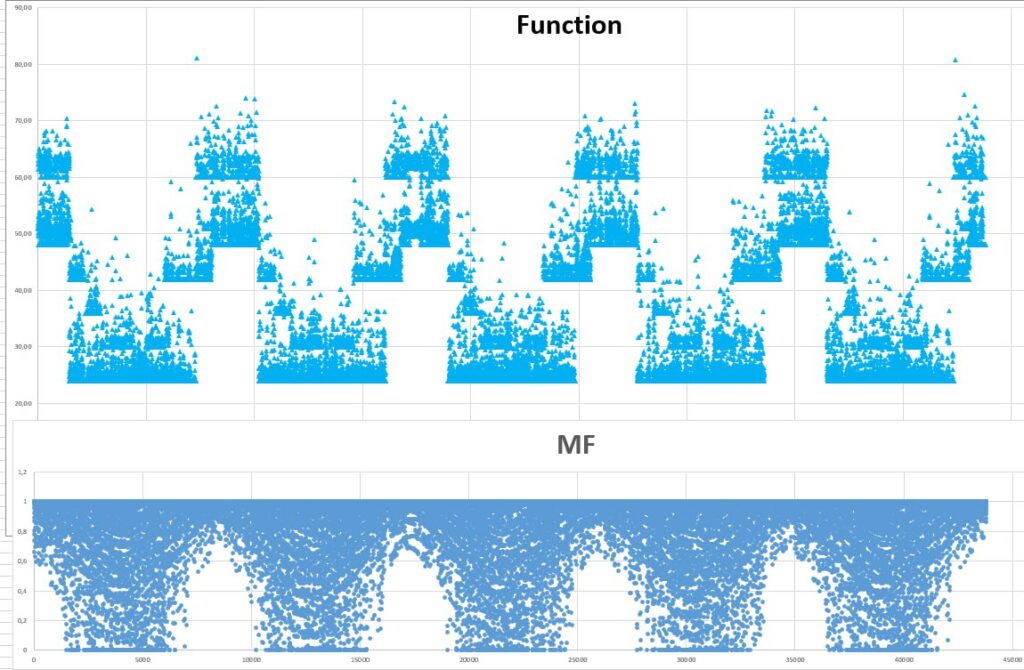1) A theory and efficient numerical methods for solving Volterra fuzzy integral equations with piecewise continuous kernels have been developed. Existence and uniqueness theorems for solutions of such a class of fuzzy integral equations are proved. The convergence of the method of successive approximations is established and an estimate of the error of the method is obtained. An efficient stable numerical method for solving such fuzzy linear Volterra integral equations based on sinc-collocation with double exponential and single exponential decay has been developed. An estimate of the accuracy of the approximate solution is obtained, with an stopping rule using the Hausdorff criterion. An integral dynamic fuzzy linear Volterra model of the first kind was developed and validated on real data to determine the mode parameters of energy storage devices (charge level and alternating power function of storage devices).
Load imbalance and its MF (5 working days period, location: Verkhnyaya Amga, Sakha Republic, Russia)

2) To solve crisp linear Volterra integral equations of the first kind with piecewise continuous kernels, the polynomial spline collocation method is proposed. In order to approximate the integrals during discretization, the proposed projection method uses the Gaussian quadrature formula. An estimate for the accuracy of the approximate solution is obtained. Stochastic arithmetic is used based on the CESTAC method (Contrôle et Estimation STochastique des Arrondis de Calculs) and the CADNA library (Control of Accuracy and Debugging for Numerical Applications). Using this approach, one can find the optimal parameters of the proposed projection method. The main theorem of the CESTAC method is proved: the equality of the number of common significant digits (NCSD) of two consecutive iterations with exact and approximate solutions is established. Thus, to show the accuracy and efficiency of the method, a new stopping rule was involved.
3) A new inverse nonlinear problem is posed and solved for the crisp Volterra integral equations with piecewise continuous kernels. For such Volterra integral equations of the first kind, it is assumed that the desired ones are the kernel’s discontinuity curves, but the rest of the information is known. The resulting integral equation is nonlinear with respect to discontinuity curves corresponding to the integration limits. For its numerical solution, a direct discretization method with a posteriori verification of calculations has been developed and tested.
4) In the field of development of theory and methods of fuzzy control of nonlinear dynamic systems with delays, Takagi-Sugeno fuzzy
models capable of approximating nonlinear systems with a given accuracy by means of accessory functions have been investigated. This allows the application of classic methods of control techniques for linear systems and Lyapunov-Krasovskii functional theory. Stability and control theory of a new class of fuzzy systems of the Takagi-Sugeno type with a time-varying delay are studied. The corresponding Lyapunov-Krasovskii functional containing special integral terms is proposed. Based on the methodology of generalized free-matrix-based integral inequality, a criterion for ensuring the stability of such fuzzy systems is formulated. The validity and feasibility of the stability criterion, as well as the method of designing fuzzy controllers, are demonstrated using the model examples.
5) An efficient strategy for charging and discharging storages based on data is proposed, taking into account wind energy forecasting intervals. Two concrete scientific results can be here distinguished. First, a power interval prediction model implemented on a long-term memory network with lower and upper bound estimation (LUBE) to quantify wind energy uncertainty. Secondly, it is an energy storage management method implemented as a Markov decision process and solved using a deep reinforcement learning method. The state space, action space, and agent-environment interaction reward function are used, and the value function is approximated via a deep Q-network. Then, according to the real-time state (such as wind power, power prediction intervals, local load, dynamic electricity price, and state of charge), the proposed approach enables an automatic charge/discharge scheduling.
Publications
- Noeiaghdam S., Sidorov D., Dreglea A. A novel numerical optimality technique to find the optimal results of Volterra integral equation of the second kind with discontinuous kernel. Applied Numerical Mathematics, vol. 186, april 2023, pp 202-212. DOI: 10.1016/j.apnum.2023.01.011.
- Yang T., Zou R., Liu F., Liu C. and Sidorov D. Improved stabilization condition of delayed T-S fuzzy systems via an extended quadratic function negative-determination lemma. Chaos, Solitons & Fractals, vol. 175, 2, 2023, 114055 DOI: 10.1016/j.chaos.2023.114055.
- Tynda A.N., Sidorov D.N. Inverse Problem for the Integral Dynamic Models with Discontinuous Kernels. Mathematics. Vol. 10, 3945, 2022. DOI: 10.3390/math10213945.
- Тында А. Н., Нойягдам С., Сидоров Д. Н. Метод полиномиальной сплайн-коллокации для решения слабо регулярных интегральных уравнений Вольтерра I рода «Известия Иркутского государственного университета» серия «математика» том 39, стр. 62—79. DOI: 10.26516/1997-7670.2022.39.62.
- Noeiaghdam S., Sidorov D.N. Application of the CESTAC method and CADNA library to control of accuracy of fuzzy Volterra integral equations with discontinuous kernels. Динамические системы и компьютерные науки: теория и приложения (DYSC 2023): материалы 5-й Международной конференции. Иркутск, 18–23 сентября 2023 г. / ФГБОУ ВО «ИГУ» ; [отв. ред. В. Г. Антоник]. – Иркутск : Издательство ИГУ, 2023, pp. 66-68.
- Noeiaghdam S., Dreglea A., Sidorov D. Fuzzy Volterra integral equations with piecewise continuous kernels: theory and numerical solution. arXiv 2023 (revised version was submitted to Fuzzy Sets & Systems).